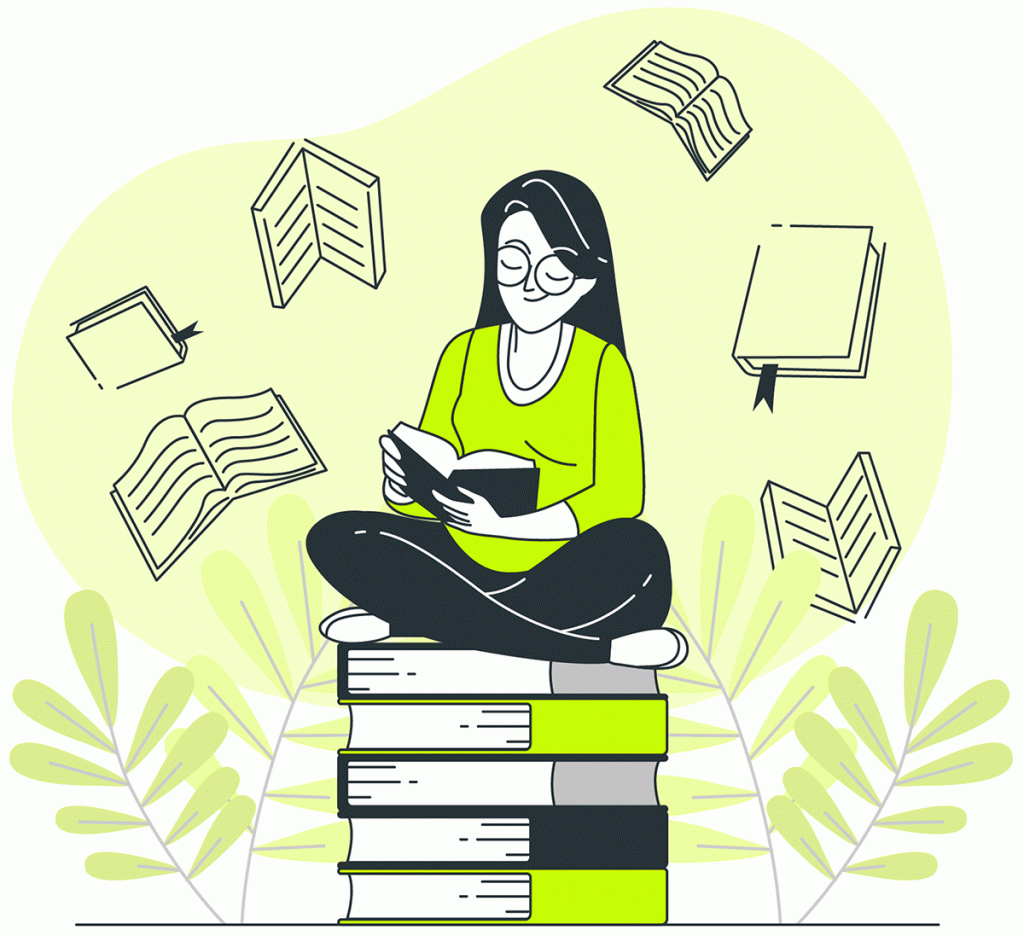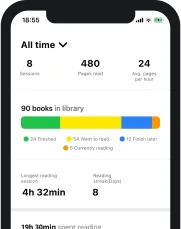Making the best of our reading habits sometimes means going the extra mile. Sometimes simply going through a book is not enough to extract the maximum value from the time we spend reading, and that is why we need to put in a little more effort from time to time.
If you’re interested in becoming the ultimate reader, you probably already heard about active reading. But what is active reading exactly? How do you do it and why should you? These are all questions that I will answer below because here at Basmo we are dedicated to helping you improve your reading technique, experience, and results.
What is active reading?
The definition of active reading states that this reading technique involves first and foremost a clear intent to understand and evaluate the material for its relevance. Active reading is a form of critical thinking and teaching methodology in which the reading is done with a higher degree of critical awareness.
Active readers ask the essential questions of “what?”, “where?”, “when?”, and “why?”. These questions are used to guide reading strategies and to improve comprehension. Active reading is a type of reading that involves proactively interacting with the text in order to gain a deeper understanding of the material.
We all know that reading has a wide range of benefits. Active reading, otherwise known as critical reading, takes these benefits to the next level. If you learn how to read actively, you can enjoy a good book and exercise your mind at the same time.
What does it mean to read actively?
The definition doesn’t exactly paint a clear picture of the active reading meaning. As explained (rather vaguely, I admit) above, this technique requires readers to be proactively involved and engaged in the text they are reading. To be able to call yourself an active reader, you need to focus on understanding the book, remembering the important details from the action, paying attention to the way it is written and the techniques the author uses, and asking yourself pertinent questions about the concepts and themes described.
Reading actively means taking notes, highlighting the important parts of the text, dissecting the information, and categorizing it in a comprehensive manner. It is an intense learning process that requires energy and determination.
Why is active reading important?
The importance of active reading goes a lot deeper than you might think. There are several things you can achieve by getting into the habit of reading actively and, among other things, there are also a couple of health benefits for you to take advantage of.
What can active reading help you achieve?
You will understand more from what you read. By reading actively, we engage with the text more, which leads to better comprehension levels. When you read actively, you are more likely to understand what you read because you have made a conscious effort to process the material. You have considered its structure and organization and have decided how best to make sense of it for yourself.
You will retain more information. Most people think that the best way to retain information is to re-read it repeatedly, but this isn’t always true. Information retention increases when readers engage in active comprehension processes while they read. When people actively engage with their reading material – such as making predictions or asking questions — they retain more information than those who simply read silently and passively absorb everything on the pages.
You will stay focused and engaged. Sometimes our mind wanders while reading and we realize that we didn’t understand much. That is highly unlikely to ever happen while reading actively. That means that you will always make the best of your reading session and you will always take full advantage of everything reading has to offer in terms of experience and gaining knowledge.
What are the benefits of active reading
Better concentration levels. Through active reading, you can manage to achieve and maintain a better level of concentration. What that means is actually not just limited to each individual reading session. Active reading can help you improve your ability to concentrate in general, not only while reading. As you can imagine, that is one important ability to have. It can be a complete game-changer in your life.
Your brain will thank you. It’s really old news that reading has a ton of benefits for you and especially your brain. Reading is a great mental exercise, a great way for you to keep your brain healthy and in shape. Active reading is, as you would expect, a much more intense training session for your brain.
You gain more from the same reading session. Taking all of the above into account, it suddenly becomes obvious that active reading is the ultimate way for you to extract maximum value from the time you spend reading. You waste no time daydreaming or re-reading the things you didn’t understand at first simply because you weren’t paying attention. You retain more from what you read. You give your brain a more intense workout. You gain more knowledge within the same timeframe.
How can you improve on perfection? Use Basmo.
Our reading tracking app is the ultimate tool for the modern reader. It is particularly effective in helping those of you who are serious about improving the reading experience and the efficiency of the reading sessions. Here’s how.
Take notes. Highlight. Annotate. Active reading means you should, well, be active. That means constantly making notes of the important information you are extracting from the material, highlighting relevant paragraphs, and annotating your thoughts.
Basmo provides you with all the necessary tools to do all that without ruining your books. The note-taking feature becomes automatically available the second you start a reading session and allows you to quickly write down all your thoughts or the things you want to remember. On top of this, the app comes with a built-in scanning feature that allows you to scan the pages of a book and then either extract the text or use the images to make your annotations or highlighting.
Set your schedule. It’s not a rule, but active reading should be organized somehow for the best results. Since it’s an activity that is going to take its toll on your levels of energy, you should generally try and program your active reading sessions.
With Basmo, that is extremely easy to do. By using the integrated scheduling feature, you can select the days of the week when you want to read and even different times for each day. The app will also remind you of the upcoming reading sessions.
Create your reading list. Some books are worth making the effort to actively read, while others are simply not. To make sure you always apply the appropriate reading technique to the book in front of you to maximize the results of your sessions, it’s generally a good idea to have separate reading lists.
With Basmo, you can easily create as many reading lists as you want and you can customize them however you see fit. That makes it quite easy to have separate lists for active and passive reading.
What are the active reading strategies?
Applying the right active reading techniques and doing your active reading properly is undoubtedly important. Here are the most relevant active reading strategies you should always be using.
1. Jot it down
Make notes, write down your thoughts, and put your observations into words. Annotate the book, and highlight the important parts. I cannot stress the importance of your active involvement in the process enough. The more you write, the more you interact with the book, its words, and its ideas, the better you will understand and remember what you read.
As I mentioned above, using Basmo is the easiest, safest, and most effective way to make your notes and annotations while reading. Give it a try.
2. Identify unfamiliar words
One key aspect of the process of active reading is that you will inevitably learn some new words. The process of trying to understand everything that is written in the book in front of you involves understanding every single word. Part of your active reading sessions will simply be looking up new words and understanding their meaning.
3. Find the main ideas
Identifying the main ideas and themes while reading is going to be an important part of your active reading sessions. This element is important for your ability to understand the material as a whole and to gain a clearer view of the author’s intentions. Active reading means analyzing the text both under a microscope and by taking a step back and looking at the material as a tiny dot in a huge context.
4. Ask questions
An active reader is inquisitive. Constantly ask questions and try to answer them. Analyze the text and try to guess where the action is going. Try to predict what the author is going to write about in the next section of the book. Be curious and always make an effort to ensure that you have a good understanding of both the actual text and the meaning behind it.
What is the purpose of the active reading strategy?
An effective active reading session should be process-oriented, flexible, strategic, and individualized. The process helps readers become more focused, improves comprehension and retention, aids reading visualization, and makes the experience more rewarding.
Active readers engage deliberately with the information and ideas in the reading material, acknowledge them, and make connections with other information they already possess.
What is the difference between active and passive reading?
When looking at active reading vs passive reading, the process of reading actively immediately becomes a lot clearer. Here are some active reading examples and some clear aspects that differentiate active and passive reading.
Active reading takes longer
Reading actively is a process that involves a lot more action on the reader’s part. This has a negative aspect on reading speed but comes with a series of other benefits that compensate for the slow progress. The speed alternates during active reading sessions depending on the difficulty of the text and the amount of information the reader needs to process. Passive reading is done quicker and at a constant speed.
Passive reading requires no reflection
Unlike active reading, passive reading can be done without putting too much thought into it. Simply reading as a form of entertainment requires a much simpler thought process and involves little or no reflection and introspection. Active reading, on the other hand, needs to be done with a clear intention to understand, a certain amount of dedication, and the desire to analyze, reflect and do introspective work to connect the information in the current book with the things you already know.
Active reading is more efficient, passive reading is more relaxing
Reading actively can take its toll on your mental stamina. Your brain will be in constant overload, trying to understand, remember, and dissect the text. Passive reading, on the other hand, is a great way to relax after a tough day or to simply pass the time. By reading passively, you engage with the text a lot less, but that doesn’t mean that you are not getting any benefits. On the contrary, certain genres are actually a lot more rewarding when passively read: erotica, romance, young adult, to name a few.
Final thoughts
Now that your question “what is active reading?” has been answered, it’s time for you to get started with this amazing process. Use Basmo to make things more interesting and effective and start understanding more of what you read, engaging with the text in a meaningful manner, and retaining more information than ever before.
Give Your Reading Experience
An Extra Boost With Basmo
Track the books you read, monitor the time you spend reading and keep notes on your reading habits and how it makes you feel. You can set yourself targets for the time you spend reading and you can get notified whenever you’re behind on your reading time.
Image by Freepik







